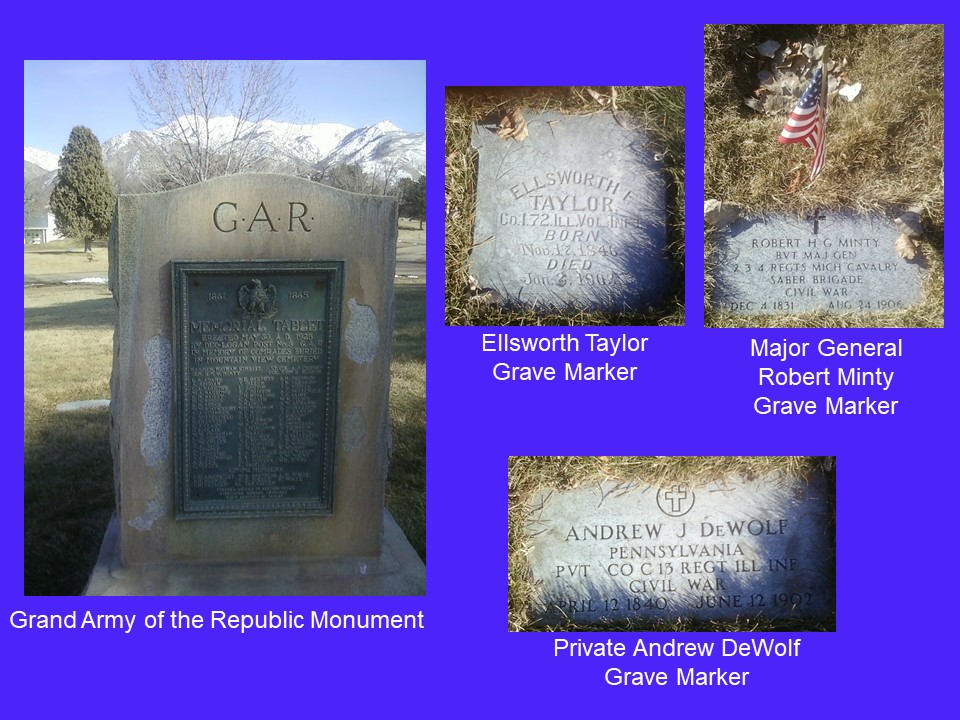Utah GAR Files-LDS Family History
Utah Department GAR Historical List of Posts
History of the Grand Army of the Republic
Utah and the Civil War – Lot Smith’s Expedition
19th Utah Department GAR Encampment
Utah Department GAR Post Information
Fort Douglas, Salt Lake City, Utah
Fort Douglas and the Soldiers of the Wasatch
Records shared by the Utah State Archives
Doug Misner
Library and Collections Coordinator
Utah State History
Email: [email protected]
Ph: 801-245-7250
Utah State Archives Research Floor
Ph: 801-533-3535
Capt. Lot Smith Camp # 1 Records found at
University of Utah Special Collections
Marriott Library
Attn: Liz Rogers
Ph: 801-581-8863
Finding Aids – Utah Division of State History
The Grand Army of the Republic and Women’s Relief Corps Photograph Collection, 1909
Utah State Department of History Research Catalog
Camp Floyd, Utah County, Utah
Established in July 1858 by a U.S. Army detachment under the command of Brevet Brig. Gen. Albert Sidney Johnston, Camp Floyd was named for then Secretary of War John B. Floyd. The detachment consisted of more than 3,500 military and civilian employees, including cavalry, artillery, infantry and support units. This unit, the largest single troop concentration then in the United States, was sent by President James Buchanan to stop a perceived Mormon rebellion, which came to be known as the Utah War.
From Fort Leavenworth, Kansas, the army marched to Fort Bridger, Wyoming where it spent the winter of 1857. Troops arrived in Salt Lake City, Utah in June 1858. Soon after their arrival, troops settled in the Cedar Valley area and eventually Fairfield, where 400 buildings were constructed by November 1858. A series of photographs of Camp Floyd, taken by Samuel C. Mills in January 1859, show the post as a cluster of adobe buildings including barracks, officers quarters, warehouses and other sundry structures. Enough civilians soon followed to increase the town size to 7000, almost half that of Salt Lake City. The rebellion never took place, leaving the army with routine garrison duty that included protecting the stagecoach and Pony Express routes, preventing Indian marauding, and mapping and surveying responsibilities.
Supplying the large garrison, 1,100 miles (1,800 km) from Fort Leavenworth, was costly. It was rumored to be an attempt by Secretary of War Floyd (a known southern sympathizer) to drain the federal treasury. A contract with the firm of Russell, Majors and Waddell for delivery of 16 million pounds (7.3 kt) of freight required 3,500 wagons, 40,000 oxen, 1,000 mules and more than 4,000 men. This same company formed the Pony Express, which had a station in Fairfield.
After Secretary of War Floyd resigned on Dec. 29, 1860 (becoming a Confederate), Camp Floyd was renamed Fort Crittenden, after Kentucky’s Senator John J Crittenden, who worked to prevent Kentucky’s secession from the Union. Camp Floyd/Crittenden was abandoned in July 1861 with the garrison being called east for the American Civil War. Equipment and buildings were sold, destroyed or transported. All that remain today are the military cemetery and one commissary building. Two months after the army’s departure, only 18 families remained in Fairfield.
A 40-acre (16 ha) area was listed on the NRHP as Camp Floyd Site November 11, 1974. The only vestige of the post in 1974 was a cemetery.
Source: https://en.wikipedia.org/wiki/Camp_Floyd_State_Park_Museum
US Generals Stationed at Camp Floyd – Historical Notes
GAR Headstone Monuments

